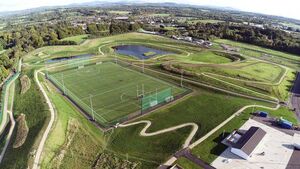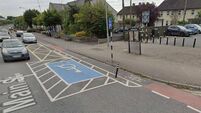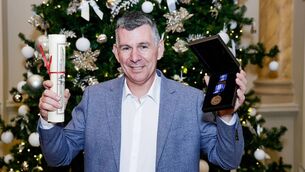Kerdiffstown Park to open this month

Kerdiffstown Park
The new €30m Kerdiffstown Park complex is set for a soft opening within three weeks – six months ahead of schedule, and five years after it began.
This was revealed yesterday (8 October) at the monthly meeting of the Naas Municipal District members in reply to consecutive queries from cllrs Bill Clear and Ger Dunne.
"We are currently working towards a soft opening at the end of October, and we anticipate a press release in the next week or so,” said Rachel Jackson from the environment section of Kildare County Council.
“The formal launch of the park will be organised around St Brigid’s Day next year,” she revealed.
“That’s a nice idea,” said cllr Clear.
“We’ll have the minister for the environment down to open that – if it’s still Eamon Ryan!” he joked.
“Seriously, this is a great thing for Kildare, and particularly Naas, because a lot of the area had terrible problems with the smells and the fire."
The Kerdiffstown Landfill Remediation Project commenced in November 2020, with a contract date for completion of construction set for April 2025 – a target they will now beat by six months.
The park – formerly the county’s landfill site - is located north east of Naas just the far side of the M7, and is accessed from a local road off the N7, and – when opened - will be a 15-year, €30m environmental rescue package of the 31Ha (80ac) site.
To assist in this process, the council procured an independent gas specialist to help with the management of the landfill gas (LFG) and to assist the contractors own landfill gas specialist.
As a remediated landfill site, Kildare County Council has ongoing environmental management and monitoring systems in place, these will be part of the future management of the site, to "ensure the protection of public health and the local environment".
The remediation works carried out on the site involved capping the site with an impermeable cap, installing 87 new gas wells, connection to a gas flare, and associated infrastructure.
The efficient management of the landfill gas generated on site involves balancing the gas extracted from all gas wells across the site to ensure that gas generated in the field is captured.
The gas is then transported, burned off in the flare and emissions are maintained in accordance with the EPA licence for the site.
The scale of the project has been quite daunting, as the council have had to seal in 193,000 cubic metres of waste, and flare off the residual hydrogen sulphide gas, whilst reinstating the facility into a 31Ha (80ac) park for sports, walking and cycling.
“You could fit 70 Aras Cill Daras in the site, to give you an example of the size,” said Ultan Downes, one of the briefing engineers.
He revealed that at least three loads of leachate is removed every day and brought to the nearby Johnstown Sewage Treatment Plant, and there are still the gas wells on site to flare off the residual gases at the site like methane and hydrogen sulphide.
“There is a high level of ammonia on the site, but it’s not flowing off, and has no impact on the Morrell river,” he added.
Kerdiffstown landfill “was as close to an environmental disaster as you can get” in 2011 when an underground fire at the site almost closed the adjacent M7.
It took 27 days to control and required the importation of a device from the Netherlands to inject liquid nitrogen into the conflagration.
The new park will contain sports pitches “for all three codes”, all-weather five-a-side pitches, changing facilities, playground with walking and cycling tracks.
The landfill was owned and operated by a private entity under licence from the Environmental Protection Agency (EPA), operating as a landfill and a waste processing facility, but ceased operations in June 2010 following a court injunction.
In 2015, Kildare County Council agreed to take over the project and remediate it. It was agreed that the Department of Environment, now Department of Communications, Climate Action and Environment (DCCAE) would fully fund the operation and remediation of the site until such a time as the site was fully restored.
Since 2015, Kildare County Council has spent just under €10 million which has been recouped from DCCAE.
The operation and management of the site is an ongoing cost that was at approximately €2 million per year but has been reduced to €1.7 million with the intention of bringing it down further to €1.5 million per year.





